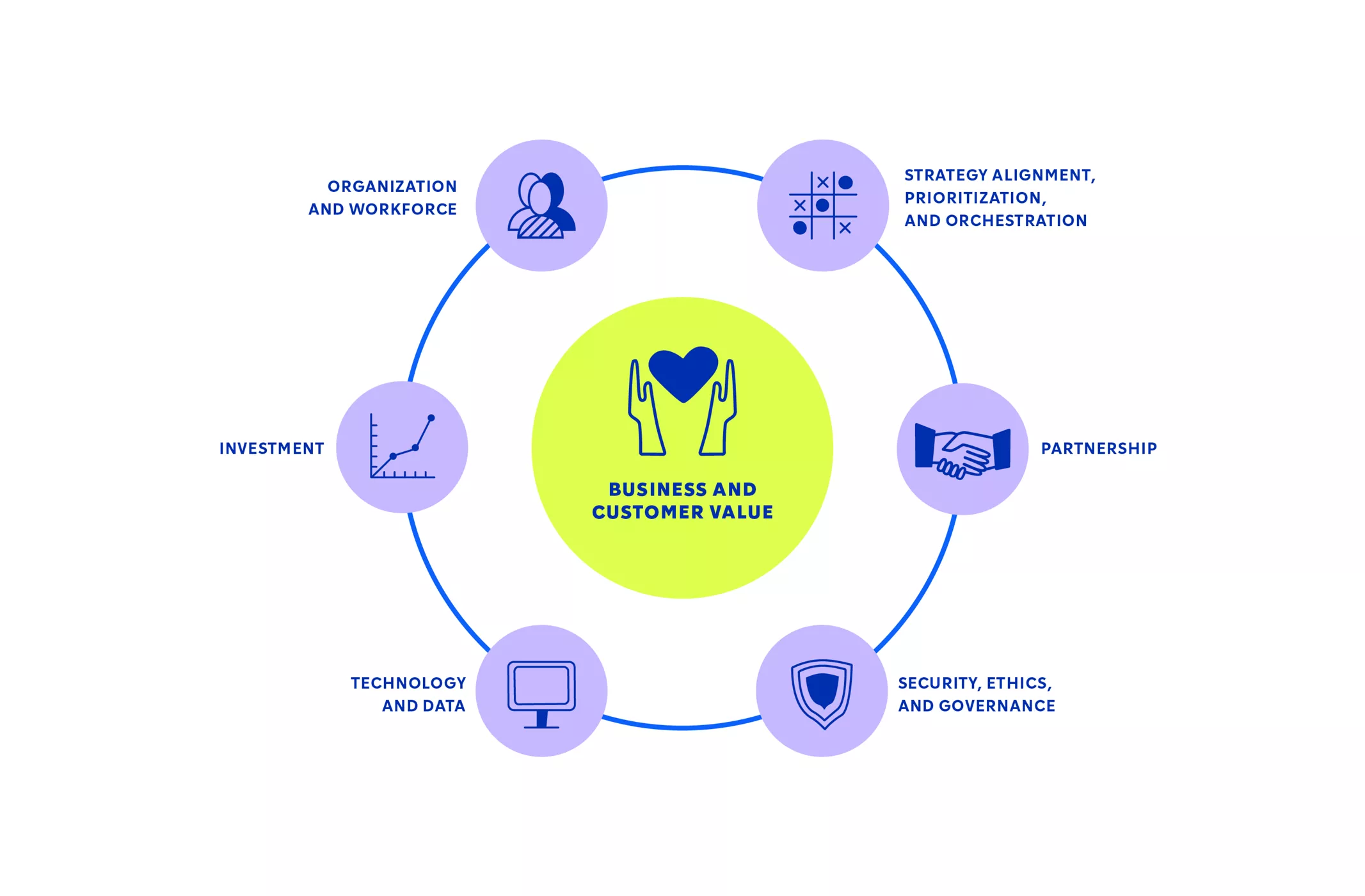The AI transformation blueprint: Six focus areas for communications companies

As we navigate through one of the most transformative eras in technology, the journey of communications companies into the world of generative AI (GenAI) has been marked by strategic experimentation and significant learning. Initially, these companies started with a narrow focus on specific use cases, which allowed them to gauge the real-world applicability of AI technologies while developing robust controls for broader usage. Today, the scene is dramatically different. AI isn’t just an experimental venture; it has become a core strategic asset that’s reshaping every facet of the industry—from internal operations to customer interactions. This evolution mirrors other pivotal technological shifts like cloud adoption, providing a contemporary roadmap rich with actionable insights.
To stand out as a leader in the field and adapt to the changing landscape in the communications industry brought on by AI, there are six focus areas to consider. With thoughtful attention here, companies can embrace AI holistically and avoid pitfalls experienced in cloud adoption.

Six strategic focus areas for AI integration
1. Data as a strategic asset
Recognizing data as a cornerstone of technological innovation, communications companies have a unique advantage due to their vast stores of first-party data. Leveraging this data effectively requires overcoming challenges such as outdated architectures and organizational silos. During the shift to the cloud, organizations were unable to fully realize the benefits of the technology without reimagining the architecture and team structures surrounding and supporting it; implementing AI into existing systems requires a similar strategy. For instance, a regional telco provider wanted to personalize service offerings and better anticipate customer needs. By revamping its data architecture to leverage customer interaction data effectively, it was able to integrate AI-driven insights into its customer service processes, leading to increased loyalty and reduced churn.
A comprehensive data strategy that focuses on long-term benefits, alignment with organizational goals, and modernization is critical. This strategy should also tackle technical debts and prepare the company for future scalability and agility. It’s important to consider the dynamic nature of this transformation as the technology, capabilities, and regulations continue to evolve.
2. Building and sustaining a skilled workforce
The demand for AI skills is creating a competitive job market where companies must attract and retain top talent, pitting communications companies against innovative startups and leading technology organizations in the fight for talent. This dynamic has necessitated a shift in talent management strategies, with an increased focus on training and upskilling.
As AI technologies evolve, so too does the need for a workforce that is adaptable and technically proficient. Organizations now need a workforce with blending and overlapping capabilities where business leaders have technical knowledge and technical leaders have business knowledge.
One global communications giant recently launched an AI academy for its employees, offering courses ranging from beginner to advanced levels. This initiative improved their workforce’s AI capabilities and boosted employee engagement and innovation.
To achieve a sustainable workforce in the AI era, strategic HR involvement is essential to design organizational structures that support continuous learning and resilience against rapid technological changes.
3. Governance framework for precision and safety
Similar to when cloud technology was in its infancy, AI transformation poses challenges for security, legal, and data privacy. Effective governance in AI initiatives is paramount to ensure that advancements are innovative, secure, and compliant with legal standards. Concurrently, it is also paramount to move at a pace to avoid losing competitive edge. The stakes are high, as missteps can lead to significant reputational damage.
An effective, aligned governance model can address the risk while guiding the transformation at the quickest, safely executed pace. This governance framework should include risk management, legal, and security teams so that companies can pursue AI innovations confidently and responsibly.
Solutions that incorporate human oversight and robust protections are critical, such as AI-enhanced customer support tools. These agent-assisting tools provide comprehensive data security and access strategies while leading to greater customer satisfaction and opportunities for upselling.
4. Prioritizing high-impact AI applications
Given the vast potential applications of AI, identifying and prioritizing the most impactful ones is crucial for strategic alignment and resource allocation. This process requires clear communication from leadership and a centralized effort to support prioritized initiatives, ensuring that they contribute significantly to the organization’s goals and deliver measurable benefits.
An international telco faced several areas of implementing AI capabilities but ultimately began its AI journey in streamlining supply chain operations. The company used predictive analytics to anticipate equipment failures and optimize inventory levels, leading to high impact with substantial cost savings and improved service reliability.
As AI is enabled across organizations, prioritize the use cases that will be most beneficial, as this will drive key metrics and build momentum for further use cases.
5. Managing costs and investments
Cost management is a critical concern as companies scale AI capabilities. Lessons from early cloud adoption highlight the importance of anticipating and managing costs proactively. Unexpected large bills can be avoided by differentiating use cases needing immediate answers from those requiring a longer timeline. Teams should also consider solving questions in-house as tens of thousands of dollars can be incurred for solutions that are available through simple online searches.
Cost-to-value strategies include clear budgeting, spending rules, and cost allocation methods tailored to different use cases, ensuring that AI investments are effective and economical.
To capitalize fully on AI investments, companies must have mechanisms in place to measure outcomes and reallocate resources effectively. This means maintaining accountability to original business cases and reinvesting the savings into strategic areas that will maximize future returns and enhance overall business performance. For example, if an AI use case results in significant cost savings in one department, create an aligned process to allocate those funds back into the same department or other priority areas so that the savings are being reinvested as they are realized.
6. Leveraging the right technologies and partnerships
The rapidly evolving AI market presents a plethora of technology options, from established platforms to emerging innovations. Making informed technology selections requires continuous assessment of the market and internal needs. Partnering with a broad spectrum of vendors and experts can help companies stay on the cutting edge while aligning their technology choices with long-term strategic goals.
Forming strategic partnerships can significantly enhance a company’s capacity to implement and benefit from AI technologies. These partnerships should focus on building internal capabilities and delivering quick wins that can provide competitive advantages, all while ensuring the workforce is equipped to manage and advance these technologies internally.


